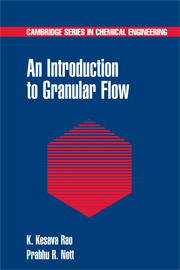Book contents
- Frontmatter
- Contents
- Preface
- Notation
- 1 Introduction
- 2 Theory for Slow Plane Flow
- 3 Flow through Hoppers
- 4 Flow through Wedge-Shaped Bunkers
- 5 Theory for Slow Three-Dimensional Flow
- 6 Flow through Axisymmetric Hoppers and Bunkers
- 7 Theory for Rapid Flow of Smooth, Inelastic Particles
- 8 Analysis of Rapid Flow in Simple Geometries
- 9 Theory for Rapid Flow of Rough, Inelastic Particles
- 10 Hybrid Theories
- Appendix A Operations with Vectors and Tensors
- Appendix B The Stress Tensor
- Appendix C Hyperbolic Partial Differential Equations of First Order
- Appendix D Jump Balances
- Appendix E Discontinuous Solutions of Hyperbolic Equations
- Appendix F Proof of the Coaxiality Condition
- Appendix G Material Frame Indifference
- Appendix H The Evaluation of Some Integrals
- Appendix I A Brief Introduction to Linear Stability Theory
- Appendix J Pseudo Scalars, Vectors, and Tensors
- Appendix K Answers to Selected Problems
- References
- Index
9 - Theory for Rapid Flow of Rough, Inelastic Particles
Published online by Cambridge University Press: 19 November 2009
- Frontmatter
- Contents
- Preface
- Notation
- 1 Introduction
- 2 Theory for Slow Plane Flow
- 3 Flow through Hoppers
- 4 Flow through Wedge-Shaped Bunkers
- 5 Theory for Slow Three-Dimensional Flow
- 6 Flow through Axisymmetric Hoppers and Bunkers
- 7 Theory for Rapid Flow of Smooth, Inelastic Particles
- 8 Analysis of Rapid Flow in Simple Geometries
- 9 Theory for Rapid Flow of Rough, Inelastic Particles
- 10 Hybrid Theories
- Appendix A Operations with Vectors and Tensors
- Appendix B The Stress Tensor
- Appendix C Hyperbolic Partial Differential Equations of First Order
- Appendix D Jump Balances
- Appendix E Discontinuous Solutions of Hyperbolic Equations
- Appendix F Proof of the Coaxiality Condition
- Appendix G Material Frame Indifference
- Appendix H The Evaluation of Some Integrals
- Appendix I A Brief Introduction to Linear Stability Theory
- Appendix J Pseudo Scalars, Vectors, and Tensors
- Appendix K Answers to Selected Problems
- References
- Index
Summary
In Chapter 7, we considered the kinetic theory of a granular gas composed of smooth inelastic spheres. However, the particles in most granular materials one normally encounters are rough, and it is therefore desirable to extend the theory to rough spheres. It is clear that particle roughness will result in the transmission of a tangential impulse during collision. We shall see that the tangential impulse is partly determined by the angular velocities of the colliding pair. As a consequence, the hydrodynamic balance of the angular momentum field, which was implicitly satisfied for smooth particles, must be enforced here.
The dimensional analysis of §7.1 does not depend on whether the particles are smooth or rough. Hence the scaling of the stress with the shear rate, particle size, and density for a granular gas composed of rough particles will be the same as that for smooth particles. However, we shall see that the form and symmetry of the stress tensor is different and that additional hydrodynamic variables are required to describe the flow of a rough granular gas.
Pidduck (1922) was the first to develop a kinetic theory for a gas of rough spherical molecules. He considered “perfectly rough” spheres, which conserve the total kinetic energy of a particle pair during collision. He determined the equilibrium distribution function and applied the Chapman–Enskog analysis to determine the first correction from equilibrium for a dilute gas; his analysis is presented (with a few corrections) in Chapman and Cowling (1964, chap. 11). McCoy et al. (1966) extended the analysis to dense gases, and Lun (1991) further extended it to a dense gas of nearly elastic, nearly perfectly rough spheres.
- Type
- Chapter
- Information
- An Introduction to Granular Flow , pp. 374 - 393Publisher: Cambridge University PressPrint publication year: 2008



